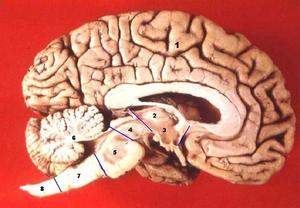Borderline personality disorder has unstable roots in terms of its origin. Before concrete diagnostic validity was established, psychoanalysts believed that Borderline personality disorder was a symptom wastebasket. The name derives from the belief that the disorder was a compilation of random symptoms from various mental disorders. It was believed that Borderline Personality Disorder bordered several disorders including: schizophrenia ( a mental disorder that makes it difficult to tell the difference between real and unreal experiences, to think logically, to have normal emotional responses, and to behave normally in social situations ), non-schizophrenia psychosis and other neuroses. Though the term ‘borderline’ has been used since the 1930s, it became an official Axis II diagnosis in 1980 following the publication of DSM-III. The belief that Borderline Personality Disorder possesses an underlying psychosis is no longer valid. However, the name ‘Borderline’ never changed with advanced knowledge. Attempts have been made to further sub-categorize BPD based on the level of social interaction and emotional functionality. In medical documentation Low-Functioning and High- Functioning forms of BPD have not been addressed. However, on support forums created by people living with BPD, they choose to use these terms. Low-Functioning BPD describes a patient who is not able to handle the most basic emotional situations. High-Functioning BPD is used to describe a person who can handle everyday situations despite the disorder.
Body Organs Affected
Borderline Personality Disorder is categorized as a mental illness. The body organ(s) that is affected is the brain.
Cause of Disease
There is a lot of controversy surrounding the exact cause of BPD; as is the case with most personality disorders. The cause varies from environment, genetic predisposition, sexual abuse, chemical imbalances, etc. Genetically, persons who suffer from this disorder are more likely to have abnormalities in the size of the hippocampus, abnormal size/ functioning of the amygdala, and abnormalities of the frontal lobe.
“Typical” Person Who Gets Disease
Borderline Personality Disorder can affect any gender, but is 75% more common in females. Males who have BPD are prone to domestic abuse and account for a large percentage of inmates. According to The Psychiatric Times 1-2% of the general population have Borderline Personality Disorder. BPD Today estimates that 20% of psychiatric patients suffer from Borderline Personality Disorder. It is also interesting to note that 75% of people who suffer from BPD have been sexually or physically abused. This disorder can also coexists with other mental disorders such as: OCD, eating disorders, post traumatic stress disorder, gender identity disorder, etc.
Symptoms
The symptoms of Borderline Personality Disorder are usually onset between teenage years and early twenties. While not as likely, onset can also occur in adults after the age of thirty. All of the symptoms listed may not be present in each individual.
- Fear of any form of abandonment whether real or imagined; accompanied by frantic or extreme efforts to avoid abandonment.
- Harbors a skewed vision of people (especially loved ones) that can tread a thin line of villain and hero from one moment to the next. This can be described as an inability to understand inconsistency in human behavior.
- Has poor self-image ‘” takes on the personality of people around them/ what they feel people would like them to be.
- Self-Loath
- Prone to impulsive and harmful behavior such as :promiscuity, substance abuse, reckless driving, law breaking, gambling, etc.
- Prone to self mutilation, suicidal behavior, or threats of harming themselves.
- Intense bouts of anger, anxiety, and depression in response to inappropriate catalysts. These episodes are usually short.
- Using disassociation, daydreaming or other form of transient behavior in order to “remove” themselves from the world.
- Migraines and severe headaches.
- A chronic feeling of emptiness
- Sadism or Masochism
- Manipulative
- Has unstable, intense, and chaotic relationships.
Diagnostic Test
Borderline Personality Disorder is difficult to diagnose because many of the symptoms can be caused by another disorder. It is also still a relatively new disorder. According to BPDFamily, graduates prior to the year 2000 have not been trained on the diagnosis and treatment of Borderline Personality Disorder. Many people are misdiagnosed and treated for other maladies. It is recommended to seek out health care professionals or Universities that are familiar with the disorder.
There are numerous test for the diagnosis of BPD, but two prove to be highly effective.
- Diagnostic Interview For Borderline Patients (DIB-R)
This test is administered by a clinician. It consists of 132 questions and 329 statements. This test was created by John Gunderson and Jonathan Kolb. It is categorized into four main parts: Affects, Cognition, Impulse, and Interpersonal Relationships. This diagnostic interview is available at no cost at the McLean Hospital in Massachusetts.
- Structured Clinical Interview (SCID-ll)
The Structured Clinical Interview is a shorter diagnostic test that was created by five health care professionals in 1997. The test is based on the (DIB-R). This test is more convenient because it can be self-administered or with the help of a loved one. The test is not utilized by hospitals or clinicians. SCID-ll is said to yield satisfactory results. It is available for $60.00 through American Psychiatric Publishing.
Treatment
- Psychotherapy
Psychotherapy is the main treatment for most personality disorders. Therapy gives the patient a non-judgmental environment to release their unsteady emotions. Therapy also gives the patient instructions on how to take control of Borderline Personality Disorder so that they can live a more mentally stable life. An effective form of therapy is titled Dialectic Behavior Therapy. This form of therapy was developed by Marsha Linehan. It draws elements from traditional Buddhist meditation and cognitive behavioral techniques. Other forms of treatment are used to accompany therapy in more severe cases. There is no “cure” for BPD. Most patients will require lifetime treatment and support.
- Medication
The use of medication accompanied by psychotherapy can be effective in treatment. There is no medication prescribed specifically to treat Borderline Personality Disorder. Anti-depression medication such as Prozac, Zoloft, and Celexa are usually prescribed. Anti-psychotics such as Zeprexa may also help to reduce mood swings associated with Borderline Personality Disorder.
- Institutionalization/ Hospitalization
Institutionalization or hospitalization is generally not recommended. The goal for long-term treatment is to teach patients how to live with their disorder. If a person behaves too recklessly or exhibits suicidal behavior than hospitalization may be a good option.
Long-term outlook
The prognosis of BPD generally depends on the person. Most people who suffer from Borderline Personality Disorder do not believe they have a problem. Denial can be a hindrance when suggesting psychotherapy. Psychotherapy and medication helps to gradually improve the patients emotional stability. However, BPD is never cured.
Prevention
Unfortunately, there are no prevention methods for Borderline Personality Disorder at this time. However, with the proper treatment and support this disorder can be controlled. As research continues to advance, more concrete information should become available. The amount of misdiagnosed people should also decrease drastically. According to J. Wood PhD, many health care professionals may avoid diagnosing patients with BPD due to lack of information.



